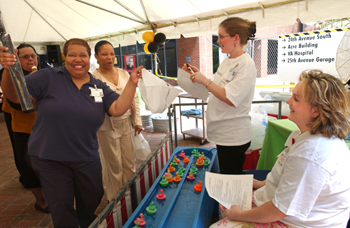
At the recent VMG celebration, Patient Services Representative Connie Williams-Dixon smiles after answering a question correctly and winning a Vanderbilt umbrella. (photo by Anne Rayner)
VMG redesigns its front desk to enhance customer service
Recently, under a party tent on the Medical Center plaza, a carnival scene took shape as Vanderbilt Medical Group celebrated a milestone in its project to improve service at front desks and in reception areas throughout the clinic.
There were balloons, games of skill, and free Nutty Buddies and ice-cream sandwiches dispensed from mammoth white Styrofoam coolers by VMG Chief Operating Officer David R. Posch.
From March to May, some 500 front-desk staff and clinic managers underwent training to help them anticipate the needs of patients, better manage waiting rooms and the patient concerns that arise there, and in general ensure that VMG’s front desk areas reflect appropriate standards of customer service.
Conducted by a team of managers and front-desk staff, the training program delves into the nitty-gritty of customer service, including guidelines for on-stage behavior à la the Walt Disney Company, and scripts for responding to common customer inquiries.
“From a front-desk standpoint, we want our patients to have the same quality of experience regardless of which clinic they enter,” said Laura W. Montgomery, director of clinic redesign and leader for the front-desk service initiative.
Customer service improvement will remain a focus for VMG for the foreseeable future, said Medicine patient care center administrative officer Betty J. Akers, who led the committee that facilitated the training.
“We’re not interested in rolling out the flavor of the month and later allowing it to drop,” she said. Training sessions for new staff are continuing on a monthly basis.
The training program is a sign that Vanderbilt is “taking more seriously the importance of the patient service representatives and the impact they have on the patient experience,” said Kim N. Pettigrew, a patient services representative in Radiology.
“This is the person the patient comes to first,” said Debra L. Walden, a PSR in the GI clinic. “You’re a representative of the institution, and the patient’s view of Vanderbilt depends on that first impression.”
The front-desk project will also include improved screening for front-desk positions and a new career ladder that will allow customer service representatives to earn more as they demonstrate higher levels of experience and competence.
The initiative also involves the creation of call centers within clinics to free front-desk staff from the phones and allow them to focus on the needs of patients. Already in use in some clinics, the phone-center approach is also proven to improve collection of patient co-pays and lower job turnover at the front desk, Akers said.













